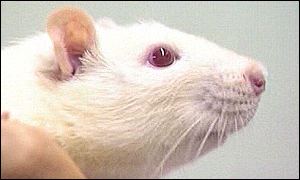
Rat genome is next
URL: http://news.bbc.co.uk/hi/english/sci/tech/newsid_1196000/1196385.stm
Date accessed: 16 March 2001
Thursday, 1 March, 2001, 17:05 GMT
Celera Genomics, led Dr Craig Venter, has been awarded a $58m (£40m) grant, shared with the Baylor College of Medicine, Houston, Texas, to read the DNA sequence of a rodent that has become a major experimental tool in biology labs across the world.
The rat project, funded by the US National Institutes of Health (NIH), will help make sense of the biochemical instructions contained within the human genome.
By comparing our genes with those of other animals, researchers will get a better idea of the functions of those genes. In this way, the rat could help scientists understand the genetic basis for common human diseases such as diabetes.
Disease 'quest'
"We are pleased to be collaborating on this NIH-funded project to sequence the rat genome," said Dr Venter, the president and chief scientific officer of Celera Genomics, which is based in Rockville, Maryland.
"We believe that by pooling our resources we can quickly unlock the mysteries of this important model organism which should aid researchers in their quest for a better understanding of basic human biology and health, and thus to find improved cures and treatments for disease."
The rat's genome is estimated to be a similar size to that of humans: about three billion base pairs of DNA.
Celera recently announced that it had completed the genome of another rodent, the mouse. But the rat is thought to be a better model for research programmes aimed at understanding, treating and preventing human diseases.
Public access
Data from the rat genome project will be released weekly into public databases, said the NIH.
Commenting on the announcement, Dr Marie Therese Bihoreau, of the Wellcome Trust Centre for Human Genetics, Oxford, UK, said: "The problem with the mouse is that it is a small animal, so it is difficult to study models of human diseases with the mouse."
She told BBC News Online: "There is growing production of rat models of animal diseases because the traits that develop are similar to human symptoms.
"Because the rat is bigger, it is easier to study diseases in rats than in the mouse."
Category: 32. Genome Project and Genomics